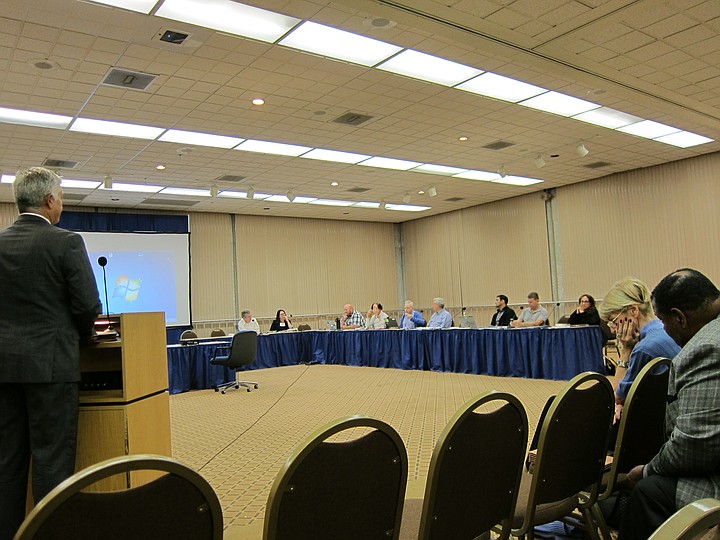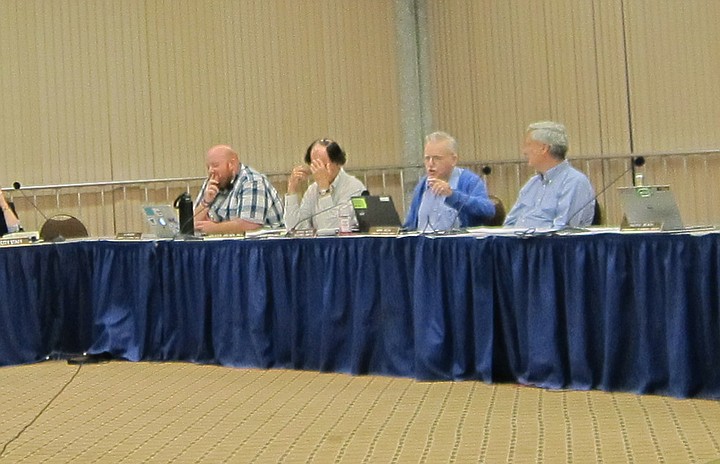 Facebook
Facebook
 X
X
 Instagram
Instagram
 TikTok
TikTok
 Youtube
Youtube

The Sustainable Energy Advisory Board is discussing community choice aggregation today. It’s a hot topic revolving around greenhouse gas emissions and whether to stay with SDG&E or create a new local government agency tasked with purchasing energy and setting utility rates. SDG&E would still deliver the electricity and send out the bills which would include charges for the city-bought energy, SDG&E’s transmission services, and a fee for no longer buying energy from SDG&E.

The advisory board responsible for advising the city council and mayor on energy policy was established in 1981 as the Energy Advisory Board in response to the oil crisis sparked by the Iranian Revolution— it was redubbed to its current moniker in 2003.

Current members appointed by the mayor include SDG&E special counsel, a public policy consultant, a labor organizer, a building industry professional, a Chamber of Commerce member, the CEO of a firm that advocates for clean technology, a solar industry advocate, construction industry professional, and an associate for the California Center for Sustainable Energy. This non-profit has been deep in the trenches with the city to move along a slow-going community choice feasibility study. The current chair is a former pharmaceutical executive.
On May 23, Francisco Urtasun talked to the community planners committee, a group made up of representatives from different local planning groups. Urtasun is regional vice president of Sempra Services, a new division of Sempra Energy, the parent company of SDG&E.
The back and forth was lively and a bit heated at times. The agenda item slated for 15 minutes went on for close to an hour.
Urtasun said more than once that he wasn’t with SDG&E explaining that utility companies aren’t allowed to advocate against community choice. He said a law was passed after a “firefight” between Pacific Gas & Electric and Marin County when they formed a community choice aggregate in 2010. The way around this for SDG&E was to form Urtasun’s new division with shareholder and not ratepayer funds in 2016. He made it clear he wasn’t lobbying against community choice but instead wanted to be part of what he described has been a very one-sided conversation full of misinformation.
His main points of contention are that choice already exists with SDG&E as 130,000 residential customers have chosen to go solar and countless commercial customers have gone direct access. According to SDG&E’s website, customers can opt for 100-percent renewable energy now if they choose.
His other beef was that community choice programs can muddy the waters with renewable energy portfolios that don’t lead to the kind of greenhouse gas emission reductions that new renewable projects produce. He explained that community choice programs use renewable energy certificates (commodities traded on the open market) that are then laid over natural gas or coal “and it counts as green.”
There were eight public speakers, all in favor of community choice. Three were from advocacy groups (Climate Action Campaign, San Diego 350, Community Energy Action Network), one was a local regulatory attorney, and another was a member of the Carmel Valley planning group that said recently they voted in favor of community choice. The other three included concerned citizens from Mira Mesa, San Carlos, and a local scientist not affiliated with any community choice organization.
More than one speaker mentioned that ratepayers could opt out of community choice and return to SDG&E at anytime. Everyone would be automatically opted-in if community choice happens. A 2015 community choice assessment stated that a fee will be charged if anyone opts to return to SDG&E. There is also an exit fee that customers would pay for leaving SDG&E, possibly for decades.
The main reason mentioned for choosing community choice was the city’s climate action plan goal to reach 100-percent renewable energy citywide by 2035. The main argument in favor was access to more renewable energy with the added benefit of lower rates.
The 2015 assessment ran some numbers that came up with a possible five percent savings over SDG&E rates with a similar SDG&E renewable energy portfolio. Because of the exit fee, the city won’t be able to offer community choice to everyone and also keep rates competitive during the first three years.
More concrete information should be forthcoming when the feasibility study is released. According to the advisory board May meeting minutes, it should go before the board late summer.
Dr. Aaron Day spoke of his concern about the disconnect of Sempra promising to reduce greenhouse gas emissions by 2035 while currently signing 20-year contracts for new natural gas plants.
The representative from the Southeast planning group said, “I’ll be damned if anyone’s going to tell me what to do with my power. If you want me to be like a real fool and spend more money so I can get an electric car and not buy any power from him [Urtasun]. But he has his virtues, he has engineers who know what the hell they’re doing.”
Clairemont’s representative said friends in Marin County (the first in California to choose community choice) have seen their utility bills decrease dramatically.
The representative from Uptown said even though solar has been heavily pushed, it’s still only a tiny percentage of the energy produced. “We talk about the horrors of natural gas. It’s 60 percent of the energy in California.” He said offshore wind turbines produce more energy than solar but joked, “Now I know Joe over here from La Jolla, you’re going to go before the La Jolla planning group and say ‘we want the offshore wind turbines all along the beach’. We’ll pick up the pieces of what’s left of you afterwards.”
He then said energy right now is akin to 1960s S&H Green Stamp trading. He said Southern California uses a lot of coal. “Many people may not realize that at night in Los Angeles, the majority of the energy is from coal. If you have an electric car, you got a coal mobile.”
The Scripps/Miramar representative cut to the chase when he called the whole debate “completely fraudulent” because neither Sempra nor community choice produces energy.
I asked Urtasun to clarify why using existing renewable energy sources don't result in the same greenhouse emission reductions as new renewable projects. He explained, “A contract with an existing resource only determines who can claim credit for an emission reduction that will already occur; it does not result in any increase in renewable generation or any decrease in emissions.”
“A renewable energy portfolio can only result in real and additional emission reductions if [it] causes more renewable energy to be generated. If a portfolio only claims credit for renewable energy that is already being generated, the portfolio will not achieve any real or additional emission reductions. That is the problem. To date, most [community choice aggregates] in California have procured most of their renewable energy and/or [renewable energy certifications] from existing resources that are already reducing emissions. While they have been able to claim credit for emission reductions that are already occurring, this kind of procurement has not led to new renewable energy development or real and additional emission reductions.”
When the community choice decision finally goes before the city council, how that vote will go can be gleaned from a few factors. One being a 2014 vote to oppose a proposed bill meant to hinder community choice. The 2014 vote went along party lines with Democrats voting to oppose the bill. Sempra lobbied in support of the dead-on-arrival bill that wanted to kill automatic opt-in for community choice.
Republican councilmembers Lorie Zapf, Scott Sherman, and Mark Kersey voted to support the bill that would have hindered community choice. Democratic councilmember’s David Alvarez and Myrtle Cole voted on the community choice side.
As far as the four current councilmembers that weren’t there for that 2014 vote — Democrat Chris Ward is likely for community choice as he took part in a community choice forum in May. Democrat Georgette Gomez is likely pro-choice since before being sworn into office, she was an associate with the Environmental Health Coalition.
The two wildcards are Councilmember’s Barbara Bry (Democrat) and Chris Cate (Republican). Sempra has lobbied all current city councilmember’s except Gomez regarding community choice and the climate action plan. Sempra has fundraised and given campaign donations to all except Gomez.


The Sustainable Energy Advisory Board is discussing community choice aggregation today. It’s a hot topic revolving around greenhouse gas emissions and whether to stay with SDG&E or create a new local government agency tasked with purchasing energy and setting utility rates. SDG&E would still deliver the electricity and send out the bills which would include charges for the city-bought energy, SDG&E’s transmission services, and a fee for no longer buying energy from SDG&E.

The advisory board responsible for advising the city council and mayor on energy policy was established in 1981 as the Energy Advisory Board in response to the oil crisis sparked by the Iranian Revolution— it was redubbed to its current moniker in 2003.

Current members appointed by the mayor include SDG&E special counsel, a public policy consultant, a labor organizer, a building industry professional, a Chamber of Commerce member, the CEO of a firm that advocates for clean technology, a solar industry advocate, construction industry professional, and an associate for the California Center for Sustainable Energy. This non-profit has been deep in the trenches with the city to move along a slow-going community choice feasibility study. The current chair is a former pharmaceutical executive.
On May 23, Francisco Urtasun talked to the community planners committee, a group made up of representatives from different local planning groups. Urtasun is regional vice president of Sempra Services, a new division of Sempra Energy, the parent company of SDG&E.
The back and forth was lively and a bit heated at times. The agenda item slated for 15 minutes went on for close to an hour.
Urtasun said more than once that he wasn’t with SDG&E explaining that utility companies aren’t allowed to advocate against community choice. He said a law was passed after a “firefight” between Pacific Gas & Electric and Marin County when they formed a community choice aggregate in 2010. The way around this for SDG&E was to form Urtasun’s new division with shareholder and not ratepayer funds in 2016. He made it clear he wasn’t lobbying against community choice but instead wanted to be part of what he described has been a very one-sided conversation full of misinformation.
His main points of contention are that choice already exists with SDG&E as 130,000 residential customers have chosen to go solar and countless commercial customers have gone direct access. According to SDG&E’s website, customers can opt for 100-percent renewable energy now if they choose.
His other beef was that community choice programs can muddy the waters with renewable energy portfolios that don’t lead to the kind of greenhouse gas emission reductions that new renewable projects produce. He explained that community choice programs use renewable energy certificates (commodities traded on the open market) that are then laid over natural gas or coal “and it counts as green.”
There were eight public speakers, all in favor of community choice. Three were from advocacy groups (Climate Action Campaign, San Diego 350, Community Energy Action Network), one was a local regulatory attorney, and another was a member of the Carmel Valley planning group that said recently they voted in favor of community choice. The other three included concerned citizens from Mira Mesa, San Carlos, and a local scientist not affiliated with any community choice organization.
More than one speaker mentioned that ratepayers could opt out of community choice and return to SDG&E at anytime. Everyone would be automatically opted-in if community choice happens. A 2015 community choice assessment stated that a fee will be charged if anyone opts to return to SDG&E. There is also an exit fee that customers would pay for leaving SDG&E, possibly for decades.
The main reason mentioned for choosing community choice was the city’s climate action plan goal to reach 100-percent renewable energy citywide by 2035. The main argument in favor was access to more renewable energy with the added benefit of lower rates.
The 2015 assessment ran some numbers that came up with a possible five percent savings over SDG&E rates with a similar SDG&E renewable energy portfolio. Because of the exit fee, the city won’t be able to offer community choice to everyone and also keep rates competitive during the first three years.
More concrete information should be forthcoming when the feasibility study is released. According to the advisory board May meeting minutes, it should go before the board late summer.
Dr. Aaron Day spoke of his concern about the disconnect of Sempra promising to reduce greenhouse gas emissions by 2035 while currently signing 20-year contracts for new natural gas plants.
The representative from the Southeast planning group said, “I’ll be damned if anyone’s going to tell me what to do with my power. If you want me to be like a real fool and spend more money so I can get an electric car and not buy any power from him [Urtasun]. But he has his virtues, he has engineers who know what the hell they’re doing.”
Clairemont’s representative said friends in Marin County (the first in California to choose community choice) have seen their utility bills decrease dramatically.
The representative from Uptown said even though solar has been heavily pushed, it’s still only a tiny percentage of the energy produced. “We talk about the horrors of natural gas. It’s 60 percent of the energy in California.” He said offshore wind turbines produce more energy than solar but joked, “Now I know Joe over here from La Jolla, you’re going to go before the La Jolla planning group and say ‘we want the offshore wind turbines all along the beach’. We’ll pick up the pieces of what’s left of you afterwards.”
He then said energy right now is akin to 1960s S&H Green Stamp trading. He said Southern California uses a lot of coal. “Many people may not realize that at night in Los Angeles, the majority of the energy is from coal. If you have an electric car, you got a coal mobile.”
The Scripps/Miramar representative cut to the chase when he called the whole debate “completely fraudulent” because neither Sempra nor community choice produces energy.
I asked Urtasun to clarify why using existing renewable energy sources don't result in the same greenhouse emission reductions as new renewable projects. He explained, “A contract with an existing resource only determines who can claim credit for an emission reduction that will already occur; it does not result in any increase in renewable generation or any decrease in emissions.”
“A renewable energy portfolio can only result in real and additional emission reductions if [it] causes more renewable energy to be generated. If a portfolio only claims credit for renewable energy that is already being generated, the portfolio will not achieve any real or additional emission reductions. That is the problem. To date, most [community choice aggregates] in California have procured most of their renewable energy and/or [renewable energy certifications] from existing resources that are already reducing emissions. While they have been able to claim credit for emission reductions that are already occurring, this kind of procurement has not led to new renewable energy development or real and additional emission reductions.”
When the community choice decision finally goes before the city council, how that vote will go can be gleaned from a few factors. One being a 2014 vote to oppose a proposed bill meant to hinder community choice. The 2014 vote went along party lines with Democrats voting to oppose the bill. Sempra lobbied in support of the dead-on-arrival bill that wanted to kill automatic opt-in for community choice.
Republican councilmembers Lorie Zapf, Scott Sherman, and Mark Kersey voted to support the bill that would have hindered community choice. Democratic councilmember’s David Alvarez and Myrtle Cole voted on the community choice side.
As far as the four current councilmembers that weren’t there for that 2014 vote — Democrat Chris Ward is likely for community choice as he took part in a community choice forum in May. Democrat Georgette Gomez is likely pro-choice since before being sworn into office, she was an associate with the Environmental Health Coalition.
The two wildcards are Councilmember’s Barbara Bry (Democrat) and Chris Cate (Republican). Sempra has lobbied all current city councilmember’s except Gomez regarding community choice and the climate action plan. Sempra has fundraised and given campaign donations to all except Gomez.
Comments